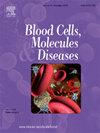Immunodeficiency in children with Diamond Blackfan and Diamond Blackfan like anemia
IF 1.7
4区 医学
Q3 HEMATOLOGY
引用次数: 0
Abstract
Background
Diamond-Blackfan anemia Syndrome (DBAS) is a ribosomopathy with erythroid failure. DBA-like picture occurs with non-ribosomal mutation and a normal rRNA maturation. Immunodeficiency in patients with DBAS is not adequately studied. We aimed to study the frequency of infections and immunoglobulins levels in children with DBAS.
Methods
Children and adolescents with DBAS were included. Infections were scored according to the immunodeficiency related score (IDR). Total serum immunoglobulin A (IgA), IgG and IgM were measured. Molecular studies were done to a group of patients.
Results
Thirty-four patients had a median age at diagnosis of 3.6 month-old. Fourteen (41 %) patients had an IDR score of ≥6, and 4 of them (28.6 %) had low immunoglobulin levels. Patients with IDR score > 6 had significantly lower IgG (471 versus 1057 mg/dl, p = 0,032) and serum IgA (24 versus 98.5 mg/dl, p = 0.015) than IDR < 6 group. We report mortality in 8 (23.5 %) patients, two of them were related to infection. Molecular analyses were performed in 8 probands and 17 relatives (5 families); 7 of the probands carried CECR1/ADA2 gene mutation and one patient carried a pathogenic variant in RPL36 gene.
Conclusion
We highlight the presence of underlying immunodeficiency in a group of patients with DBA and DBA-like disease.
患有钻石黑扇和钻石黑扇样贫血的儿童免疫缺陷
diamond - blackfan贫血综合征(DBAS)是一种伴有红细胞功能衰竭的核糖体病。非核糖体突变和正常rRNA成熟时出现类似dba的图像。DBAS患者的免疫缺陷尚未得到充分研究。我们的目的是研究DBAS患儿的感染频率和免疫球蛋白水平。方法以儿童和青少年为研究对象。根据免疫缺陷相关评分(IDR)对感染进行评分。测定血清总免疫球蛋白A (IgA)、IgG和IgM。对一组病人进行了分子研究。结果34例患者诊断时中位年龄为3.6个月。14例(41%)患者IDR评分≥6,其中4例(28.6%)患者免疫球蛋白水平低。IDR评分患者>;6例患者IgG (471 vs 1057 mg/dl, p = 0.032)和血清IgA (24 vs 98.5 mg/dl, p = 0.015)明显低于IDR和lt;6组。我们报告了8例(23.5%)患者的死亡,其中2例与感染有关。对8名先证者和17名近亲属(5个家族)进行分子分析;7例先证者携带CECR1/ADA2基因突变,1例患者携带RPL36基因致病性变异。结论:我们强调在DBA和DBA样疾病患者中存在潜在免疫缺陷。
本文章由计算机程序翻译,如有差异,请以英文原文为准。
求助全文
约1分钟内获得全文
求助全文
来源期刊
CiteScore
4.90
自引率
0.00%
发文量
42
审稿时长
14 days
期刊介绍:
Blood Cells, Molecules & Diseases emphasizes not only blood cells, but also covers the molecular basis of hematologic disease and studies of the diseases themselves. This is an invaluable resource to all those interested in the study of hematology, cell biology, immunology, and human genetics.

 求助内容:
求助内容: 应助结果提醒方式:
应助结果提醒方式:


